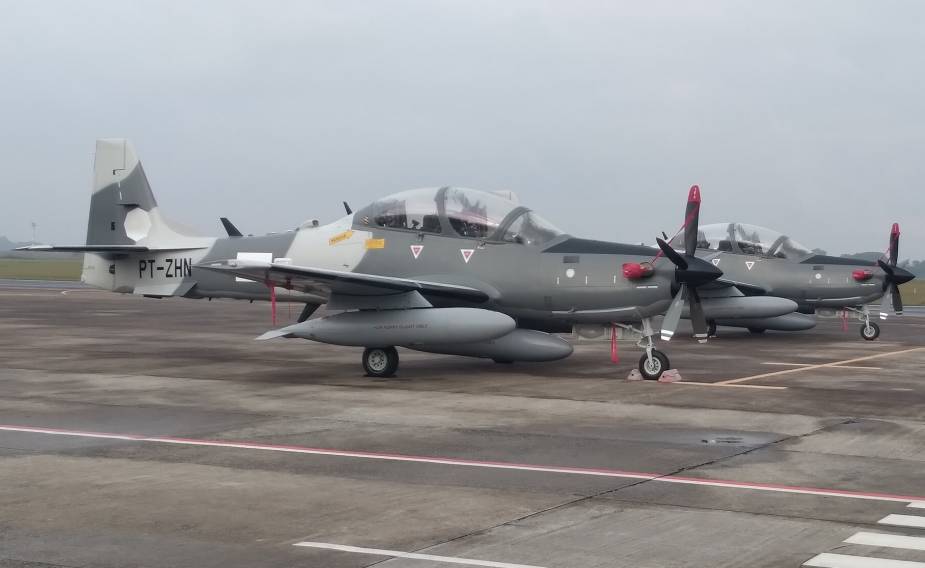According to Scramble Magazine, on 14 June 2021, the next three Embraer A-29B Super Tucano light attack aircraft for the Turkmenistan Air Force were seen at São José dos Campos, Brazil.
Follow Air Recognition on Google News at this link
 Embraer A-29B Super Tucano light attack aircraft for the Turkmenistan Air Force (Picture source: via Scramble Magazine)
Embraer A-29B Super Tucano light attack aircraft for the Turkmenistan Air Force (Picture source: via Scramble Magazine)
On 14 June 2021, the trio started its delivery flight. The aircraft have their roundels and serials taped over but are registered PT-ZHN (c/n 314000272), PT-ZHK (c/n 314000273) and PT-ZHO (314000274). Their future serials most probably will be 03 Blue, 04 Blue respectively 05 Blue. On 6 June 2021, Scramble Magazine reported on the delivery flight of the first two Super Tucanos for Turkmenistan. The number of aircraft ordered is still not confirmed, but most probably will be five.
The Embraer EMB 314 Super Tucano, also named ALX or A-29, is a Brazilian turboprop light attack aircraft designed and built by Embraer as a development of the Embraer EMB 312 Tucano. The A-29 Super Tucano carries a wide variety of weapons, including precision-guided munitions, and was designed to be a low-cost system operated in low-threat environments. In addition to its manufacture in Brazil, Embraer has set up a production line in the United States in conjunction with Sierra Nevada Corporation for the manufacture of A-29s to export customers.
The aircraft differs from the baseline EMB-312 Tucano trainer aircraft in several respects. It is powered by a more powerful 1,600 shp (1,200 kW) Pratt & Whitney Canada PT6A-68C engine (compared to the EMB-312's 750 shp (560 kW) powerplant); has a strengthened airframe to sustain higher g loads and increase fatigue life to 8,000–12,000 hours in operational environments; a reinforced landing gear to handle greater takeoff weights and heavier stores load, up to 1,550 kilograms (3,420 lb); Kevlar armor protection; two internal, wing-mounted .50 cal. machine guns (with 200 rounds of ammunition each);[7] capacity to carry various ordnance on five weapon hardpoints including Giat NC621 20 mm cannon pods, Mk 81/82 bombs, MAA-1 Piranha air-to-air missiles (AAMs), BLG-252 cluster bombs, and SBAT-70/19 or LAU-68A/G rocket pods on its underwing stations; and has a night-vision goggle-compatible "glass cockpit" with hands-on-throttle-and-stick controls; provision for a datalink; a video camera and recorder; an embedded mission-planning capability; forward-looking infrared; chaff/flare dispensers; missile approach warning receiver systems and radar warning receivers; and zero-zero ejection seats.[8] The structure is corrosion-protected and the side-hinged canopy has a windshield able to withstand bird strike impacts up to 270 knts (500 km/h; 310 mph).
In 2012, Boeing Defense, Space & Security was selected to integrate the Joint Direct Attack Munition (JDAM) and Small Diameter Bomb to the Super Tucano. In 2013, Embraer Defense and Security disclosed that its subsidiary, OrbiSat, was developing a new radar for the Super Tucano. A Colombian general disclosed that the side-looking airborne radar would be able to locate ground targets smaller than a car with digital precision.
















